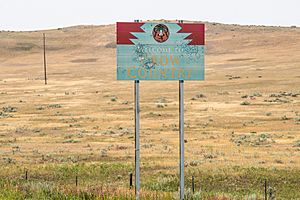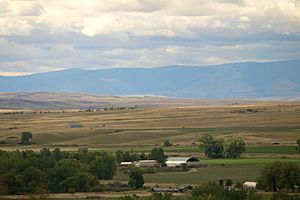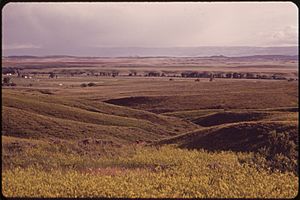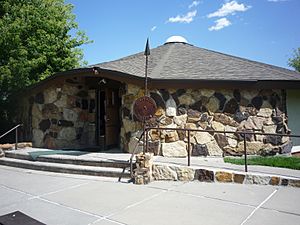Crow Indian Reservation facts for kids
Quick facts for kids
Crow Indian Reservation
|
||
|---|---|---|

Welcome sign
|
||
|
||

Location in Montana
|
||
| Tribe | Crow (Apsáalooke) | |
| Country | United States | |
| State | Montana | |
| Counties | Big Horn Treasure Yellowstone |
|
| Established | May 7, 1868 | |
| Headquarters | Crow Agency | |
| Government | ||
| • Body | Crow Tribe Executive Branch | |
| Area | ||
| • Total | 3,606.54 sq mi (9,340.9 km2) | |
| • Land | 3,593.56 sq mi (9,307.3 km2) | |
| Population
(2017)
|
||
| • Total | 7,096 | |
| • Density | 1.96754/sq mi (0.75967/km2) | |
| GDP | $1.9 Billion (2018) | |
| Website | crow-nsn.gov | |


The Crow Indian Reservation is the special homeland of the Crow Tribe. It was created in 1868. This reservation is in southern Montana, in the United States. It covers parts of Big Horn, Yellowstone, and Treasure counties.
About 11,000 people are part of the Crow Tribe. Around 7,900 of them live on the reservation. About 20% of the people living there speak the Crow language as their first language.
This reservation is the largest of the seven Indian reservations in Montana. It is located in south-central Montana. The state of Wyoming is to its south. The Northern Cheyenne Indian Reservation is to its east. The reservation includes parts of the Bighorn Mountains, Wolf Mountains, and Pryor Mountains. The Bighorn River flows through it. The main office for the reservation is in Crow Agency, Montana.
The reservation has a land area of about 3,593 square miles (9,307 km²). Its total area, including water, is about 3,606 square miles (9,339 km²). This makes it one of the largest reservations in the country.
Contents
History of the Crow Reservation
Early Times and Treaties
The Crow Indian Reservation is located in the traditional lands of the Crow people. In 1805, a fur trader named Francois-Antoine Larocque visited the area. He traveled with a Crow group near the Little Bighorn River.
The reservation today is in the middle of the Crow territory. This land was described in the Fort Laramie Treaty of 1851.
In the 1860s, the Crow people faced challenges. People from Europe moved north of the Yellowstone River. Also, the Lakota (Sioux) moved into Crow lands from the east. This led to a new treaty.
The 1868 Treaty
On May 7, 1868, the Crow Tribe sold about 30 million acres of their land. They agreed to live on a smaller reservation. This new reservation was about eight million acres. It was defined by specific lines and the Yellowstone River.
Major F. D. Pease was the first government agent for the Crow reservation. He served from 1870 to 1874.
Changes to Reservation Borders
Over the years, parts of the reservation were sold to the United States. This happened in 1882, 1892, and 1906. These sales reduced the size of the reservation.
In 1917, there were attempts to open more of the reservation land. Crow chief Plenty Coups and Robert Yellowtail worked to stop this. They held a special ceremony and prayed for help. Their efforts succeeded, and the land was not taken.
Robert Yellowtail made history in 1934. He became the first Native American to be the superintendent of his own tribe's reservation.
The reservation got its current shape after small land changes in 1937. More changes happened in the 1960s when the Bighorn Canyon Dam was built.
In the 1960s, Pauline Small became important. She was the first woman to hold a tribal official position on the Crow reservation.
Coal Resources and Economy
In the 1970s, the Crow people learned about the large amount of coal under their land. The Crow Nation owns about 1.4 billion tons of coal. This is enough to supply the United States for a year.
The Absaloka coal mine on the reservation provides half of the tribe's money that doesn't come from the federal government. This mine opened in 1974. It employs many people. However, the decline in coal mining in the United States has affected the tribe.
In 2013, the tribe and a company called Cloud Peak Energy planned to open a new mine. This mine would have brought a lot of money to the company. However, President Barack Obama stopped the mine. He also paused new coal leases on public lands.
Communities on the Reservation
Several towns and communities are located within the Crow Indian Reservation:
- Crow Agency, Montana
- Fort Smith, Montana (part)
- Hardin, Montana (part)
- Lodge Grass, Montana
- Pryor, Montana
- St. Xavier, Montana
- Wyola, Montana
Historic Places and Attractions

The most famous attraction on the reservation is the Little Bighorn Battlefield National Monument. This is where a famous battle took place on June 25, 1876. Combined forces of the Lakota, Northern Cheyenne, and Arapaho tribes fought against the 7th Cavalry Regiment. This regiment was led by George Armstrong Custer. Crow scouts helped guide Custer, as they were defending their own reservation.
Another important place is Chief Plenty Coups (Alek-Chea-Ahoosh) State Park and Home. It is near the town of Pryor. This park has a small museum about Chief Plenty Coups and the Crow Tribe. You can also see the chief's old lodge house and grocery store, which are preserved.
Notable Events
Since 1904, the Crow people have held a large event called the Crow Fair. It is known as the "Teepee Capital of the World." This fair traditionally takes place during the third week of August.
Popular Culture
The PBS TV show Reading Rainbow filmed part of an episode on the reservation. This was on June 17, 1983. The episode was called "The Gift of the Sacred Dog." It was based on a book by Paul Goble. The actor Michael Ansara narrated it.






